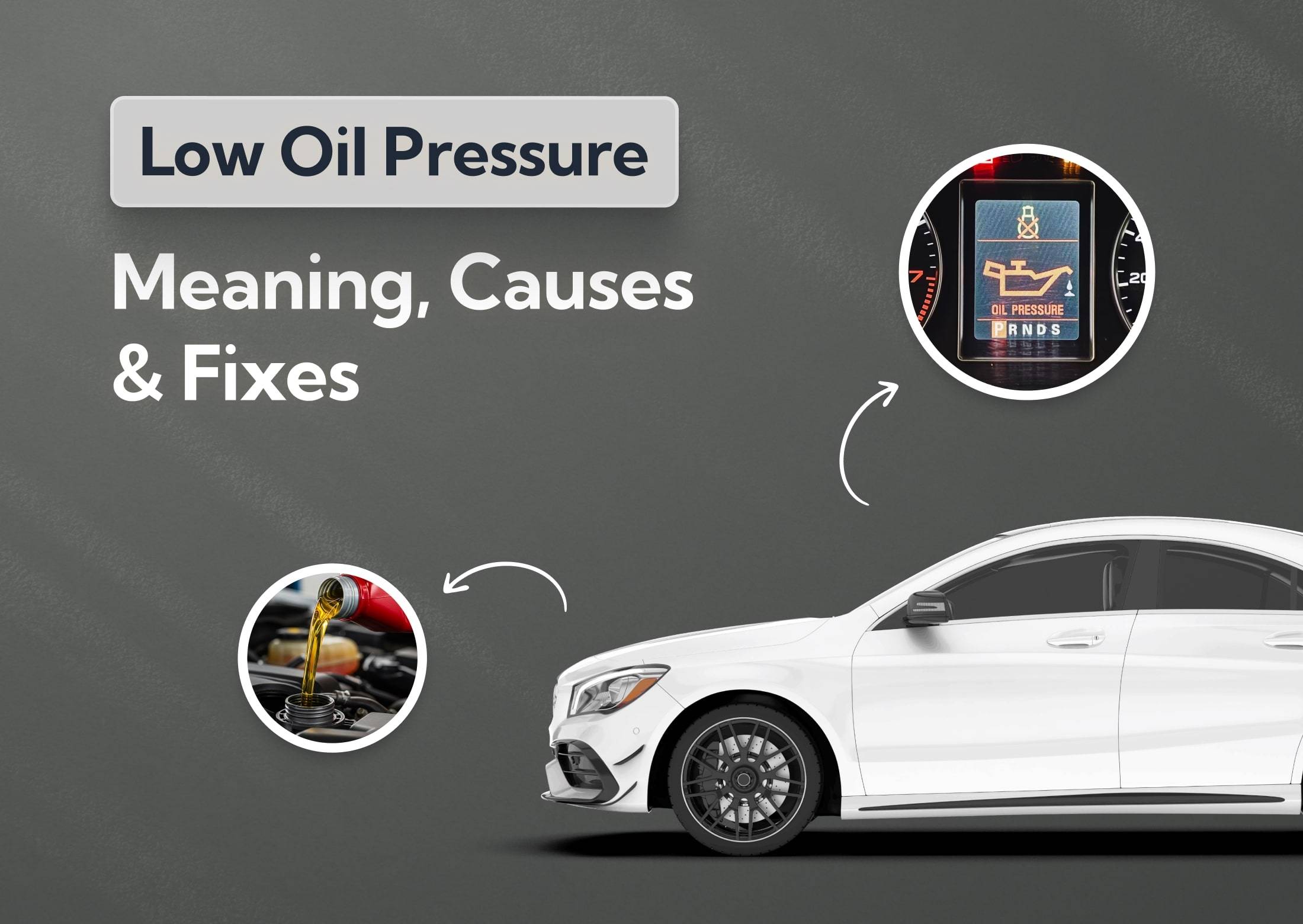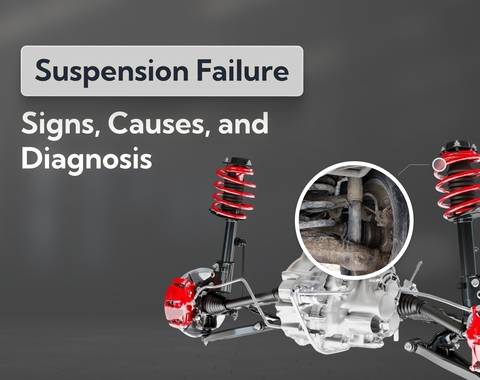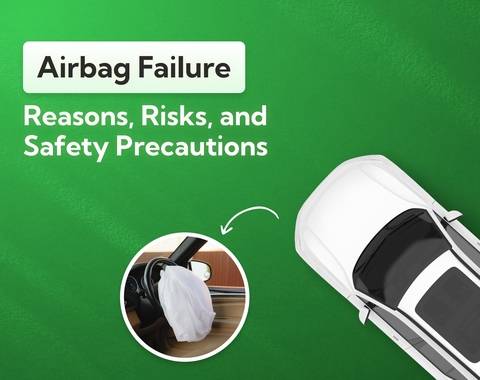Low Oil Pressure: Meaning, Causes & Fixes
Low oil pressure is one of those problems that creeps up quietly but can absolutely wreck your car if you ignore it. Learn what causes it, what it means for your engine, warning signs, how to fix it and more in this comprehensive guide.
Last updated: 31st October, 2025

Award-winning automotive entrepreneur, tech innovator, and founder of Car.co.uk, NewReg.co.uk & Recycling Lives.

Listen to this story
Engine oil pressure keeps metal parts lubricated so they aren’t grinding against each other. If it’s too low, friction builds and your engine components overheat, which eventually results in serious damage and complete engine failure.
Low oil pressure usually points to one of a few things: not enough oil in the system, a clogged filter, a worn-out oil pump or using the wrong oil grade. You’ll know something’s wrong when the oil light flickers on, the engine starts ticking or performance suddenly drops.
In today’s article, I’ll walk you through the causes, signs and fixes for low oil pressure, as well as my best preventative tips to keep this from happening in the first place.
What's in this article
What are the causes of low oil pressure?
Low oil pressure occurs when your engine isn’t circulating enough oil to keep its moving parts properly lubricated. That can happen for a few reasons: low oil level, the wrong oil viscosity, a worn pump, a clogged filter or simply wear and tear inside the engine itself.
Low oil level
Engines need enough oil to build and maintain pressure. If you’re running low, the pump starts pulling in air instead of oil. That’s when the pressure dips, that thin layer of lubrication between parts disappears and the warning light flicks on.
This happens for simple reasons: you’ve gone too long between oil changes, there’s a leak somewhere or the engine’s burning oil through worn seals or piston rings.
Either way, it’s the most preventable cause of low oil pressure. Make it a habit to check your oil every few weeks (especially before long trips). A quick dipstick check can save you from a very expensive repair later.
Incorrect oil viscosity
‘Viscosity’ is just a fancy word for how thick or thin your oil is. Too thick for your engine and it struggles to flow through tight engine passages, especially on cold starts. Too thin and it slips through too easily, leaving gaps that reduce pressure and lubrication.
Manufacturers specify the exact viscosity your engine needs for a reason. Modern engines are built with tight tolerances and the wrong oil grade can throw everything off.
If you’ve recently changed oil brands or grades and suddenly notice a pressure warning, double-check the spec in your owner’s manual. A quick correction there might very well save you from a lot of unnecessary panic (and a potential breakdown).
Bad oil pump
The oil pump is the heart of your lubrication system. It’s what dissipates the oil across the crankshaft, camshaft and pistons to lubricate them. If you have a bad oil pump, the result is high friction, overheating and metal-on-metal contact that destroys your engine components.
You might hear ticking or knocking noises, see your oil light flickering even though your oil level is fine or notice your engine is overheating from the additional friction. All of these are strong hints the pump’s worn or struggling.
If you suspect the oil pump’s failing, stop driving and get it checked. Replacing a pump isn’t cheap (£500 to £1,000), but it’s nothing compared to rebuilding an engine that’s run dry.
Clogged oil filter
The oil filter’s there to trap dirt, metal shavings and other debris so they don’t circulate through the engine with the oil. When it gets too dirty or hasn’t been changed in ages, oil can’t pass through freely. The pump has to work harder, and eventually pressure falls off.
Most modern engines have a bypass valve that lets oil flow even if the filter’s blocked — but that means unfiltered oil is now moving through the system, carrying grit that wears down components.
The fix is simple: replace the oil filter regularly. It’s one of the cheapest bits of maintenance you can do, and it can save your engine from a world of hurt.
Engine wear
Engine wear is a slower, sneakier cause of low oil pressure. It builds up over time — thousands of miles of heat, friction and start-stop driving gradually open up the clearances between moving parts.
As bearings, pistons and camshaft journals wear down, oil flows through them more easily. That wider gap means lower oil pressure, even if your oil level and pump are fine.
This is where preventive maintenance really becomes important. There’s no ‘quick fix’ for engine wear, but routine oil changes, fluid top-ups and coolant system maintenance dramatically improve your engine’s lifespan.
What are the signs of low oil pressure?
Low oil pressure makes itself known pretty quickly if you’re paying attention. Your car has a few built-in ways of warning you something’s not right under the bonnet, like dashboard lights. But you’ll also notice the subtle aspects, like new noises and heat build-up.
Oil warning light
This is the big one. When that red oil can icon lights up, that’s your first and clearest signal. It means the oil pressure has dropped below a safe level and needs to be looked at.
If you notice the oil warning light turn on, pull over, turn the engine off and check your oil level before doing anything else. Ignoring it even for a short drive can cause damage if there’s a serious issue underneath.
Engine noise
When oil pressure drops, there’s not enough lubrication between moving parts, and that’s when the noise starts. You might hear a light ticking from the top end, or a deeper knocking from the bottom of the engine. Those sounds mean metal parts are hitting each other instead of gliding smoothly on a film of oil. If you hear them, stop driving and get it looked at ASAP.
Diminished engine performance
Because oil reduces friction and helps parts move smoothly, low pressure makes everything inside the engine work harder. Pistons drag, bearings heat up and overall efficiency drops. You’ll feel it when you hit the gas; the car feels lazy, like it’s fighting itself.
If your car becomes less responsive, accelerates slower than usual or starts to rough idle, don’t just assume it’s in your head. Lift up the bonnet and check things out for yourself.
Oil leaks
Sometimes you’ll see the evidence before you feel it. Oil spots on the driveway or a greasy coating around the sump, filter or valve cover could mean you’re losing oil faster than you realise. Leaks lower oil levels, which then lowers pressure. It’s a quick downward spiral.
Engine overheating
Oil isn’t only a lubricator. It also helps carry heat away from your engine’s internal parts. So when pressure drops, heat starts building up. If your temperature gauge is creeping up and the oil light’s on too, shut the engine off immediately and take a look.
How to fix low oil pressure
Fixing low oil pressure starts with figuring out why it’s happening. There’s no single fix that applies to every car. Sometimes it’s as simple as topping up low oil or swapping a clogged filter. Other times it’s a worn pump or tired engine parts that need replacing.
The key is not to guess. Diagnose first. Driving with low pressure while you “see if it sorts itself out” is one way to potentially destroy your engine.
Check the oil level.
The first and easiest step in fixing low oil pressure is to check your oil level. It takes just a few minutes and will instantly tell you whether you’re dealing with something simple or something serious.
Here’s how to do it properly:
- Park on level ground and switch off the engine. Wait a few minutes so the oil drains back into the sump.
- Pop the bonnet and locate the dipstick. It’s usually a brightly coloured handle near the engine.
- Pull it out, wipe it clean with a cloth or paper towel, then reinsert it fully.
- Pull it out again and check where the oil sits between the “min” and “max” marks.
- If it’s below halfway, top it up slowly using the correct oil grade. Don’t overfill, though, because too much oil can also cause pressure issues (the crankshaft could turn the excess oil into foam).
Tip: The oil should look smooth and amber or dark brown. If it’s milky, gritty or smells burnt, that’s a separate issue and a sign it’s time for a service.
Use the correct oil viscosity.
Using the correct oil viscosity matters because your engine is built with precise clearances between parts. The oil has to be the right thickness to flow quickly at cold start and still protect under high heat.
You can find the right viscosity for your engine in your owner’s manual or on the oil cap itself. It’ll look like something like 5W-30 or 0W-20. The first number shows how the oil flows in cold temperatures; the second is how it performs when hot.
Replace the oil filter.
If your oil filter is clogged or hasn’t been changed in a while, it chokes the oil flow which causes lower pressure.
The easiest way to know if it’s time to replace the filter is to check your service history. The garage replaces your filter every time they do an oil change to keep the new oil clean and protect the engine. So if it’s been more than 5,000 to 7,500 miles since your last oil change, the filter’s due.
You can also spot trouble early if the oil looks dirty right after a change or the pressure light flickers even with good oil levels. Those are signs the filter might be restricting flow.
Inspect and replace the oil pump.
If the oil level, filter and viscosity are fine but the oil light still flickers, especially at idle, that’s a red flag. You might also hear deeper knocking noises from the engine, since the pump isn’t supplying enough oil to the bearings. A mechanic can confirm it with a pressure gauge test.
As for replacing the pump, it’s not a DIY-friendly job. It usually sits behind the timing cover or inside the oil pan, which means draining the oil, removing several engine components and resealing everything.
The general process goes like this:
- Drain the oil and remove the sump or oil pan.
- Detach any parts blocking access (usually the timing belt or chain cover).
- Unbolt and remove the old pump.
- Clean all surfaces thoroughly.
- Fit the new pump with fresh seals or gaskets.
- Reassemble, refill the oil and check for leaks or pressure issues.
Unless you’re experienced with engine work, I’d recommend heading to a garage for this. Replacing an oil pump takes hours and in some cases requires you to remove the whole engine.
Address engine wear.
To monitor engine wear, watch for flickering oil lights at idle, metallic ticking, oil pressure slowly dropping over time and increased oil consumption. Regular oil analysis (yes, garages can test it) can also show metal content in the oil, which gives you a clear picture of internal wear.
As for addressing it, if your car’s already showing signs of heavy wear, you’ve got two options:
- Partial repair, where specific components like bearings or seals are replaced, or
- Full rebuild, where the engine is stripped, cleaned, machined, and reassembled with new internals.
A rebuild is expensive, but for new, high-value and classic cars, it could be worth it. For older runarounds, you might be better off scrapping the car and putting that money toward something newer and more reliable (more on this in a bit).
What is the cost of fixing low oil pressure?
Fixing low oil pressure costs anywhere from £20 to over £5,000, depending on what’s causing it. A simple top-up or sensor replacement is cheap. But if you’re looking at a worn oil pump or severe engine damage, you could be facing major repair bills or even a full replacement.
Typical repair costs:
- Oil pressure sensor replacement: £20 to £150
- Oil and filter change: £60 to £200
- Oil pump replacement: £300 to £1,000
- Minor leak repair: £100 to 5400
- Engine rebuild or replacement: £1,000 to £2,500+ (rebuild); £1,500 to £5,000+ (replacement)
Costs vary depending on a few key factors: labour rates (London garages charge more than small towns), your car’s make/model and the availability of parts. High-performance and luxury engines are more complex and expensive to repair. And if oil starvation has already caused internal damage, the costs escalate fast.
Sensor replacement
Replacing an oil pressure sensor usually costs £20 to £150, depending on your car’s make and model. The part itself is inexpensive but the final bill depends on how buried it is in the engine bay. Some are easy to reach; others require removing covers or intake parts, which adds labour time.
Oil pump replacement
A failing oil pump is one of the more expensive fixes for low oil pressure. The job can take several hours because the pump sits deep inside the engine behind the timing cover or inside the sump.
Labour makes up most of the cost here. On some cars, the engine has to be lifted or partially removed to reach the pump. That’s why the total bill can range from £300 to £1,000 depending on complexity, car type and labour rate.
Still, replacing it early is far cheaper than letting the engine run dry and seize.
Oil filter and oil change
Replacing the oil and filter is standard maintenance and should be done at least once a year or every 5,000 to 7,500 miles. It’s the cheapest and most common fix, and more often than not it’ll prevent almost every other issue on this list if you take care of it regularly.
Expect to pay £60 to £200 for a full oil and filter change. You’ll spend on the lower end if you drive a generic car like a Ford Fiesta or Toyota Corolla. And you’ll pay closer to £200 if you drive something higher-end like a BMW or Mercedes.
Engine repairs due to wear
If your engine has worn bearings, piston rings or internal scoring, low oil pressure might be a symptom of deeper damage. At this point, you’re looking at either an engine rebuild or replacement. This one’s the most expensive, but also the most variable.
A rebuild (stripping and repairing the existing engine) typically costs £1,000 to £2,500+, while a replacement can run £1,500 to £5,000+, depending on the car and parts availability.
Like the other types of repair work, labour is the main cost driver here. Rebuilding engines is incredibly time-intensive, and replacement engines require sourcing, shipping and reprogramming.
When should you consider scrapping your car due to low oil pressure?
You should consider scrapping your car when the damage from low oil pressure outweighs the cost of repair. If your engine’s already suffered major wear, seized bearings or internal scoring, the repair bill climbs into the thousands. At that point, it’s worth comparing the cost of fixing it against the car’s current market value.
Factors like mileage, age, condition and how often the problem keeps returning all matter when deciding whether to scrap your car. If repairs would cost more than half of what your car’s worth or you’re constantly battling oil pressure issues, scrapping it is usually the more sensible move.
High repair costs
When the cost of repairing low oil pressure issues approaches your car’s total value, it’s time to think twice. Replacing an oil pump or rebuilding an engine can easily run into the thousands, and that’s before adding labour and new fluids.
What we use at Car.co.uk is the ‘50% Rule’. If repairs cost more than 50% of the car’s value, scrapping is the smarter and lower-risk option.
Severe engine damage from low oil pressure
Driving with low oil pressure for too long causes irreversible damage to the bearings, camshafts and pistons. Once those parts are compromised, repairs involve a full engine teardown or replacement, both of which are costly and time-consuming.
If your mechanic says there’s metal debris in the oil or the engine’s seized, it’s only worth replacing the engine if the car’s new (less than 5 years) and you plan to get at least half a decade more use out of it. Otherwise, scrap it.
What the experts say

Anthony Sharkey
Repeated engine failures or repairs
If you’ve already fixed oil pressure problems once or twice and they keep coming back, the underlying issue might be structural wear inside the engine. Replacing sensors and filters only treats the symptoms, not the cause. When problems persist despite regular maintenance, it’s a sign that the engine’s at the end of its life.
Excessive wear beyond repair
Every engine has a lifespan. When excessive wear causes pressure to drop even after using the correct oil and maintaining it properly, you’ve likely reached that point. Rebuilding might bring it back, but again, it’s rarely cost-effective for older cars. In these cases, scrapping the vehicle and upgrading to something more reliable saves money, time and stress in the long run.
Preventive tips to avoid low oil pressure
The best way to deal with low oil pressure is to stop it from happening in the first place. Fresh oil, clean filters and the right viscosity keep your engine running smoothly and the pressure stable. Check your oil level monthly, fix leaks early and never skip scheduled services.
Staying ahead of these simple tasks costs far less than repairing a worn pump or replacing an engine. And it’s what keeps your car reliable for years instead of months.
Regular oil changes
Old oil breaks down, thickens and can’t flow properly through tight clearances. Routine changes fix that. Most manufacturers recommend an oil change every 5,000 to 10,000 miles or once a year, whichever comes first. Short trips, heavy loads and older engines need it more often.
Check oil levels regularly
You should check your oil at least once a month (more often if your car’s older or you drive long distances).
To do it properly, make sure the engine’s off and has cooled for a few minutes, then pull out the dipstick, wipe it clean, reinsert it and check the level. It should sit between the “min” and “max” marks.
Top up slowly if it’s low and always use the right oil grade. A five-minute check saves you thousands in future repairs.
Use the correct oil type and viscosity
Different engines and climates call for different oil grades. Thinner oils like 0W-20 work best in cold weather and modern engines with tight tolerances. Thicker ones like 10W-40 are better for older engines and in hotter climates.
Using the wrong viscosity will either starve your engine of oil or flood it with sluggish flow. Always check your owner’s manual for the correct type and if you’re unsure, most garages will tell you exactly what your engine needs.
Maintain the oil filter
A clean, high-quality filter keeps contaminants out of your engine and stabilises the pressure. Neglecting it lets debris build up, forcing the pump to work harder and lowering oil pressure, so replace it every time you change the oil. It’s one of the cheapest bits of maintenance you can do, and it pays off every mile you drive.
Monitor for oil leaks
Keep an eye on your driveway for dark spots and check under the bonnet for residue around the oil pan, valve cover and filter housing. If you smell burning oil or see smoke, you may have a gasket leak dripping onto hot components. All of these lead to low oil pressure.
Frequently asked questions
You shouldn’t drive with low oil pressure for any meaningful distance. Stop as soon as it’s safe, turn off the engine and check your oil level. Even a few minutes of driving with insufficient pressure might cause severe internal wear or total engine failure.
Yes, absolutely. Low oil pressure roughens the metal engine components and causes them to grind against each other. The longer you drive like that, the more they overheat and the faster the damage spreads. Bearings, pistons and camshafts eventually seize completely, leading to catastrophic engine failure that’s beyond repair.
A faulty oil pressure sensor often triggers a blinking or constant oil warning light and shows inaccurate readings on the gauge. To confirm it, use an OBD-II scanner to check for error codes. If the code points to the sensor circuit, replacing the sensor should solve the problem.
Sometimes. Start with the basics. Check your oil level, make sure the viscosity matches manufacturer specs and replace the oil and filter if they’re old. If pressure is still low, inspect or replace the sensor. Only consider the pump if simpler fixes don’t work.
About Car.co.uk

Share on
Latest news & blogs










